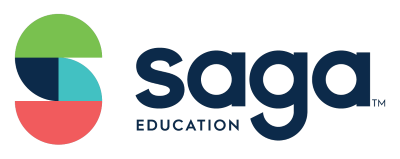Effective Tutoring Needs a Tutoring Curriculum
February 27, 2024An effective high-impact tutoring curriculum is crucial for student success as it offers comprehensive support to tutors. When tutors are well-prepared, students reap the benefits. A successful tutoring curriculum enhances student outcomes and provides tailored learning opportunities for students and tutors. It is important to note that tutors have distinct roles in supporting students’ learning in small groups, unlike classroom teachers.
Halley Bowman, Senior Director of Academics at Saga Education, shares her expertise on how an effective tutoring curriculum can support student success at your school.
Differentiated Support for Tutors
While tutors collaborate with teachers, paraprofessionals, and other school staff to assist students in their learning, their role is inherently different. Tutors are typically not certified educators and need more pedagogical support.
Given that tutors generally possess a different level of knowledge, training, and education than teachers, providing them with a curriculum that supports their effectiveness with students is crucial. Just as we differentiate instruction and resources for students, we must also differentiate training, resources, and approaches for tutors.
At Saga Education, we provide comprehensive training to tutors, aligning it with their specific role, students’ learning needs, teachers’ lessons, and school districts’ objectives. Through our experience, we have observed that tutors achieve moderate success when using a curriculum designed for teachers but experience great success when using a curriculum tailored specifically for tutoring.
Tutors can make some progress when implementing problems with their small groups of students. However, when we enhance these problems with targeted instructional and content support specifically designed for tutors, the impact of the tutorial sessions shifts from satisfactory to highly effective for learners.
Over time, by utilizing a curriculum that includes embedded tutor-specific supports, we have witnessed improvements in tutors’ pedagogical content knowledge (PCK), ability to navigate student learning, and facilitation of tutorial sessions. We can elevate their impact and enhance student learning by providing tutors with a curriculum and support system for their role.
Components of an Effective Tutoring Curriculum
Differentiated learning with a supportive adult
“The more supportive adults there are to care about a student’s learning, the greater their academic success,” comments Bowman. Students arrive at 9th-grade Algebra I with vastly different backgrounds, proficiency in skills and prior knowledge. Personal experiences, native language, and prior learning can differ from student to student. High-impact tutoring is relationship-driven, and providing students with individualized lessons with another consistent and invested adult is another opportunity to meet their individual needs.
Culturally relevant lessons
Lessons that embrace diversity and inclusion reflecting the real world, can greatly enhance students’ understanding of information. When students can relate to the lessons, they become more tangible and relevant to their own lives.
For instance, instead of asking a student living in a city about the amount of wallpaper needed to cover the walls of a room in their home, tutors can use real-life scenarios that the student can easily recognize. They can use examples like calculating how many days the student can afford bus fare with different amounts of money or determining the number of lunches they can buy with a fixed allowance. This approach promotes critical thinking while honoring students’ backgrounds and identities.
“When students feel like active participants in the learning process, where dialogue and questioning are encouraged, they realize that learning is a collective experience. The knowledge is already within them, and the tutor helps bring out the right pieces at the right time. Our students need to understand their own potential for learning,” states Bowman.
An effective tutoring curriculum provides students with both a mirror and a window. The mirror allows students to see themselves reflected in their work. At the same time, the window offers a different perspective on the people and world around them, showing how math is intertwined with their daily lives and the lives of others.
Providing tutors with prompts, resources, and support
“Tutoring curriculums provide direct questions that allow them to assess individual student understanding, figure out what students know, and where they might have unfinished learning or confusion. With many teaching curriculums, teachers know how to ask a good question to access for comprehension.” The limitations of a teaching curriculum, however, is that they do not always accommodate varied learning styles and gaps in learning without one or two students falling behind.
Throughout the year, tutors develop assessment skills to help them zero in on learning gaps through the resources and training provided through their tutoring curriculums. In-school, high-impact tutoring curriculum supports tutors alongside students. Saga’s tutoring curriculum gives tutors prompts, suggestions, and support. Because many tutors are new to working with students, they need guidance and support to answer questions, respond to student needs, and overcome challenging or new situations.
“Tutors have a lot of decisions to make in their tutorial [when connecting with their students]. So, the better we can help them with the right materials to facilitate conversations with their students, the more effective educators they will be. Eventually, they will refer to the training less and less throughout the year as they grow confident in their ability to facilitate. These are the type of support we put into our tutoring curriculum. We prepare our tutors to respond and support effectively.”
The Hidden Benefits of an Effective Tutoring Curriculum
Measuring learning outcomes in a tutoring curriculum differs from a teaching curriculum. Unlike the former, a tutoring curriculum goes beyond academic achievements and considers a student’s intrinsic growth. Tutors are equipped with the skills to uncover hidden capabilities and curiosities in students, enabling them to step outside their comfort zones, take risks in their learning, and actively participate in classroom discussions.
Tutors, in turn, acquire the skills to cultivate purposeful positive connections with their students. Fostering positive relationships accelerates the tutor-student dynamic and academic advancement, as the tutor establishes themselves as a reliable and supportive adult for students to turn to.
A tutoring curriculum is designed to be flexible and responsive to the changing requirements of students, teachers, and schools. These curriculums evaluate students’ comprehension and identify any areas of confusion or misunderstanding. They also adapt to address any gaps in a student’s ability to complete their assignments effectively. Additionally, tutoring curriculums aim to overcome obstacles hindering a student’s learning process. Providing praise and constructive feedback is crucial in boosting students’ confidence and motivating them to achieve their learning objectives.
Lastly, by offering guidance and correction in a personalized and secure environment, students can enhance their ability to recognize learning opportunities and develop critical thinking skills.
 |
Halley Bowman is a proven strategic leader with over 15+ years of experience in leading and studying academic initiatives in education non-profits. She specializes in mathematics education and high-dosage tutoring in historically underserved communities. |
